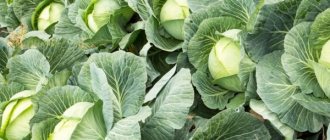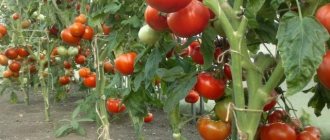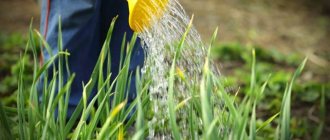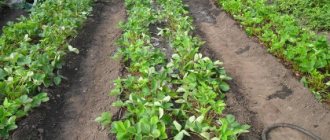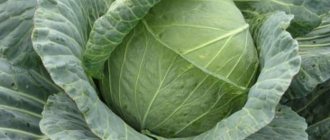Description of the hybrid variety
Appearance of cabbage:
- Leaves. Large, semi-raised, collected in horizontal or slightly raised rosettes. The leaves are oval, waxy, wrinkled. Color – light green. The edges are slightly concave and wavy. The inner leaves are snow-white.
- Heads of cabbage. Large size, dense, round.
- Kocheryzhka. Small size. Length – up to 14-15 cm.
Megaton cabbage seeds
To grow large heads of cabbage, you need to apply a sufficient amount of mineral fertilizers, otherwise the harvest will not please you with its gigantic size
The heads of cabbage grow large, dense, round in shape
Reviews
Megaton is popular among gardeners and has received many good reviews:
- Tatyana, Samara has been planting megaton for several years now. He notes that the variety is very shelf-stable, it can be stored in the basement until May, the heads of cabbage do not burst and retain their taste. Megaton heads of cabbage are very dense, suitable for pickling and long-term storage.
- Alexandra, Moscow region. – notes that the heads of cabbage are very large, suitable for pickling, and have good taste.
- Anna, Tula region. – I planted the seedlings in mid-May, in June – in open ground. Due to the late planting time, the Megaton heads of cabbage turned out smaller and did not crack.
- Svetlana, Penza - Megaton - favorite variety, simply huge, delicious. We plant every year.
If you follow all the recommendations, then a good harvest of Megaton cabbage will pleasantly please the owners themselves and surprise the neighbors.
Varietal characteristics
Characteristics of Megaton cabbage:
- Mid-season variety. From emergence to harvest - 4.5-5.5 months (136-168 days).
- The weight of heads of cabbage at the stage of technical ripeness is 3.5-4 kg. If you create the most favorable conditions for cabbage, you can grow heads weighing 12-15 kg.
- Heads of cabbage contain 3.9-4.9% sugar. Ascorbic acid (vitamin C) – up to 43.5 mg, proteins – 3%, dry matter – 8-8.8%.
- The taste characteristics are high. The leaves are juicy, crispy, slightly sweet, with a pleasant taste and smell.
- Purpose: fermentation and salting.
- Resistant to clubroot, fusarium wilt, and gray rot.
- Productivity – 650-850 centners per 1 ha, 9 kg per 1 sq. m.
Origin of cabbage Megaton
Megaton was included in the Russian State Register of Breeding Achievements in 1996, but many gardeners are still discovering this magnificent hybrid for the first time. The originators include the Dutch company Bejo Zaden. Indeed, this cabbage came to us from abroad thanks to subsidiaries that operate in the Moscow region and Rostov-on-Don.
Cabbage hybrid Megaton was developed by specialists from the Dutch company Bejo Zaden
Bejo Zaden is a large seed corporation operating in 30 countries. The business is family-owned and was founded more than 50 years ago. The founders started by growing carrots and onions, and today about 50 crops are presented on their official Internet portal, 1,200 varieties and hybrids have been bred, and seeds are supplied to more than 100 countries.
Megaton cabbage is one of Bejo Zaden's masterpieces. In Russia, it has not yet become popular and beloved only because of the poor awareness of our gardeners about its excellent qualities and the huge range of seeds. It is difficult to find truly worthwhile ones among the many beautiful packages. The authors included the hybrid in the “For pickling” category, but it is a universal cabbage. The heads of cabbage become dense and juicy long before technical ripeness and are suitable for summer salads. Megaton is well kept fresh in the cellar until spring.
Video: what grew from 10 Megaton cabbage seeds
I can’t describe this hybrid without emotion. I planted Megaton for the first time last year and was delighted with the results from the moment the seeds sprouted and all summer until harvest. I guess I chose the wrong varieties before. It wasn’t cabbage that kept growing for me, but a complete misunderstanding: sometimes the heads of cabbage didn’t set, sometimes small ones grew on a long stalk and fell to one side. Once normal forks grew, but they were all cracked. And in the rainy summer, my cabbage simply rotted right in the garden bed, never making it to autumn. After all the failures, I already wanted to abandon this culture altogether. But I still gathered my willpower and decided to prove to myself that I know how to grow cabbage. I chose Megaton F1 after reading reviews on the forums. They wrote about such large heads of cabbage that “you have to stuff them into the refrigerator in pieces.”
The compassionate housewife was afraid that the leg would not withstand the weight of a head of cabbage of the Megaton hybrid, and substituted a brick
Advantages and disadvantages of the variety
Advantages of the Megaton variety:
- High yield.
- Great taste.
- There is no tendency for heads of cabbage to crack due to temperature changes.
- Tolerates transportation well.
- Resistant to many cabbage diseases.
Megaton has few disadvantages:
- Short-term storage – from 1 to 3 months.
- Freshly harvested heads of cabbage have harsh leaves.
- It is necessary to carefully select the site for planting - the hybrid needs moderate partial shade. Cabbage does not grow well in direct sun.
Advantages and disadvantages of Megaton cabbage - table
| Advantages | Flaws |
| High yield | Large and heavy heads of cabbage require physical effort during harvesting, transportation, and take up a lot of space in the refrigerator and storage |
| Large heads of cabbage with juicy leaves are ideal for pickling | There is a possibility of fungal diseases |
| Can be grown as early cabbage for summer consumption | The price of seeds is higher than for regular varieties, and there are few of them in a bag - usually 10 pieces. |
| Excellent taste without bitterness | |
| All heads of cabbage are aligned | |
| High seed germination |
Video: a specialist from Belarus talks about the characteristics of the Megaton hybrid
Preparing for landing
Before planting, prepare the site and seed material. Soil preparation begins in the fall:
- The soil is being dug up. Remove remnants of weeds and rhizomes found in the soil.
- Apply organic fertilizers before frost. It is best to add humus or rotted manure - this organic matter perfectly stimulates the growth of heads of cabbage. The norm is 10-12 kg per 1 sq. m.
- Apply mineral fertilizers - 30 g per 1 sq. m.
- In the spring, the soil is dug up again, adding urea and potassium sulfate - 40 g per 1 sq. m. m.
In soils with high acidity, yields drop by 20-30%. Lime, wood ash, and dolomite flour are added to acidic soils.
Megaton is planted with seedlings or seeds in open ground. Seed material is prepared for sowing as follows:
- Hardening. Seeds are immersed in warm water (50-55°C) for 20 minutes. Immerse in cool water for 5 minutes.
- Growth stimulation. Immerse for 12 hours in special growth stimulants. The most popular stimulants are Epin and Zircon. Or you can prepare a solution of nitrophoska - take 1 tsp per 1 liter of water. The seeds treated in the stimulator are washed and slightly dried.
Bedding
Before planting in open ground, seedlings should be tall (15 to 20 cm), with a thick stem and have 4 to 6 leaves. Megaton cabbage is planted around the end of May. Although the timing is approximate, it all depends on the climatic conditions of the region.
Attention! Strong seedlings of Megaton cabbage can withstand night frosts down to -3 degrees.
The beds for planting cabbage of the Megaton variety are prepared in the fall, choosing an open sunny place for this. It is important to remember that cabbage is not grown on the same beds where cruciferous vegetables grew. It is best to plant cabbage after legumes, carrots, and onions. In autumn, the ridges are cleared of plant debris, rotted manure is added (mineral fertilizers can be used) and dug up.
In spring, you don’t have to dig up the soil, but immediately make holes at a distance between plants of at least 50-60 cm. For ease of care, Megaton cabbage, according to the description of the variety, is planted in a two-row manner, as in the photo below.
Comment! The holes are filled with hot water with potassium permanganate (from the black leg) and a handful of wood ash is added.
The plants are removed from the ground and carefully inserted into the hole, directing the roots straight down. When covering seedlings with soil, they focus on the first true leaf. It should rise above the surface. Immediately after planting, water the cabbage.
Site selection, soil and conditions
How to choose a site:
- The soil. Well-water- and breathable soils are needed. Acidic soils are not suitable - they can provoke clubroot. The best options are chernozems and cultivated loams. Areas that are flooded after precipitation are not suitable - Megaton does not like soils that are too wet.
- Lighting. This hybrid does not tolerate direct sunlight. On the other hand, constant shading is also harmful. To create ideal conditions for cabbage, it is recommended to plant sunflowers or corn between the rows. Planting frequency: every 3-4 rows of cabbage. Megaton grows best in partial shade. It cannot be planted near evergreen bushes and trees - due to a lack of lighting, the yield will decrease.
- Predecessors. Suitable areas are those where cabbage and other cruciferous vegetables - radishes, radishes, turnips, etc. - have not been grown for at least 3-4 years. It is best to plant Megaton after potatoes and tomatoes. It is recommended to change the growing location every year - this reduces the risk of the hybrid contracting cabbage diseases.
Description of the hybrid
This hybrid is medium-late, since it takes from 138 to 168 days from the moment the cabbage sprouts until it fully ripens. When ripe, the heads of cabbage have a smooth, slightly flattened shape with large rounded leaves and a dense white internal structure. The stump in ripe cabbage is short, which adds advantages to this hybrid. The leaves have wavy lines at their tips and create a large rosette around the stem. The color of the foliage is green with a gray tint and a waxy coating of medium intensity.
The average weight of Megaton forks is from 3 to 5 kilograms. However, under favorable conditions their weight can reach 15 kg. The best condition for cabbage to produce a good harvest is climate moderation.
To ripen, it needs a large amount of sunlight, but very moderate watering, since when the soil is very wet, the head of the hybrid begins to crack, and when there is drought, it stops developing.
Mid-season hybrid Krautman F1
Gardeners and gardeners like the unpretentiousness of the white cabbage hybrid Krautman F1. They also value it for its productivity. Read more..
Therefore, the northern regions of the Russian Federation have the most ideal climate for sowing this crop. But it is imperative to choose a time for planting seedlings when there are no longer severe night frosts. However, this does not apply to rooted plants, since Megaton is a frost-resistant hybrid. Only young seedlings can die when exposed to minus temperatures outside at night.
The yield of Megaton F 1 is high and amounts to 586-934 c/ha, which allows you to grow a hybrid for sale. This is facilitated by high product characteristics.
A lot of useful substances are found in 100 grams of Megaton cabbage:
- Protein – 0.6-3%
- Ascorbic acid – 39.3-43.6 mg
- Sugary substances – 3.8-5%
- Dry matter – 7.9-8.7%
From this description it is clear that the presence of sugars in cabbage is pronounced, which makes it sweet and indispensable for pickling. This cabbage has a special juiciness and crunch from the moment it is removed from the garden. Moreover, in the first months its leaves are a little rough, which does not allow it to be fully used in fresh salads. You have to knead it slightly first.
Non-seedling planting
When planting seeds directly in open ground, cabbage roots grow deeper than when growing seedlings. This feature increases resistance to drought, but will delay ripening by about 2-3 weeks. Growing seeds by sowing in the ground is easier than the seedling method, but does not guarantee 100% germination.
Features of seedless cultivation:
- Seeds are sown in late April-early May. Exact dates vary by region. Sow the seeds in heated soil, and the temperature outside should be +15°C. In cold soil, seeds do not germinate for a long time; they swell at a temperature of 5°C. The higher the temperature, the faster the seeds will hatch - at 20°C the seeds hatch in 4-5 days, at 10°C - after 2 weeks.
- Holes are made in the ground at intervals of 40-45 cm. The depth of the holes is 3-4 cm. 0.5 liters of water are poured into them.
- The seeds are planted to a depth of 1 cm. 3-4 seeds are placed in one hole. The distance between the rows is 60-70 cm. The seeds are sprinkled with soil on top.
- Sprinkle the crops with sawdust or humus to prevent the formation of a crust that will interfere with the development of seedlings.
- The crops are covered with film - it is pulled over the arcs. You can also use cut plastic bottles and cans for insulation. When the temperature outside rises, the shelter is removed for ventilation. Before the seedlings appear, the soil is moistened with a sprinkler.
- Thinning of seedlings is carried out after the formation of two leaves - 2 sprouts are left. When 3 leaves appear, thin out the plantings again, leaving only one sprout.
Table of main characteristics
| Variety or hybrid | hybrid |
| Ripening time | mid-late |
| Kochan | round, dense |
| Kocheryzhka | short |
| Disease resistance | high resistance to diseases and pests |
| Fruit weight, g | 3000-5000 |
| Growing areas | northern and central regions of the Russian Federation, northern Ukraine |
| Disembarkation scheme | 60cm x 40cm |
| From germination to ripeness | 136-168 days |
| Seed placement depth | 1.0-1.5 cm |
| Seedling age | 50-55 days |
| Soil temperature for planting seeds/seedlings | +4/+12 |
| Advantages | resistant to diseases, pests and cracking, excellent commercial quality, wonderful taste |
| Flaws | hard leaves in 1 month of storage, short shelf life |
Planting seedlings
Growing seedlings lasts 115 days. This method requires a lot of work - you need to grow seedlings, pick them and transplant them into open ground.
How to transplant cabbage seedlings of the Megaton variety into open ground, see the video below:
How to sow seeds for seedlings?
Seeds for cabbage seedlings should be sown from mid-March to the third ten days of April. They grow seedlings in separate glasses - then they skip the picking stage. If seedlings are grown in boxes, after a certain time they have to be planted in pots.
Seeds are prepared for sowing in the usual way - hardened and disinfected. Sowing order:
- The seeds are sown in containers filled with substrate - you can buy it or prepare it yourself. The soil mixture is prepared by mixing humus, sand and turf soil in equal parts. The resulting mixture is disinfected with Fitosporin.
- Place two or three seeds in one glass. Seeds are sown in a row at intervals of 1 cm - this is when sowing in boxes. Between rows - 3 cm.
- Cover with soil, moisten with a spray bottle and cover with film. Until the shoots appear, the container with the crops is kept warm - at a temperature of +20-25°C.
- After 4-5 days, sprouts appear. If seedlings are grown in boxes, the seedlings are thinned out, increasing the gaps between neighboring seedlings to 2 cm. If seedlings are grown in glasses, only one sprout is left - the healthiest and strongest is chosen.
- The seedlings are watered with warm water as soon as the top layer dries.
- Thinned seedlings are placed in a room or greenhouse - during the day the temperature there should be maintained at +18...+20°C, at night - +12...+15°C. Temperature changes are necessary to harden seedlings.
- If necessary, turn on additional lighting to extend daylight hours. With a lack of light, seedlings stretch out and weaken.
It is recommended to sow seeds for seedlings several times - so that the newly growing seedlings can replace those that cannot take root in the beds.
How to pick seedlings?
Picking is carried out after the appearance of the third true leaf. Seedlings from the box are transplanted into glasses. But first the soil is watered to make it easier to remove them. Seedlings are planted in pots, buried to the level of cotyledon leaves.
How to feed the seedlings?
While the seedlings are growing, until they are transplanted into open ground, fertilizing is carried out three times.
Frequency and composition of fertilizers for seedlings:
| Period | Feeding composition |
| After the first leaf appears | Add ammonium nitrate (12 g), superphosphate (20 g), potassium salt (5 g), diluted in water. The dosage is given per 5 liters of water. |
| A week after the first feeding | Water with mullein solution. Ammonium nitrate is also suitable (15 g diluted in 5 liters). |
| A couple of days before transplanting into the ground | Ammonium nitrate (15 g), potassium salt (10 g) and superphosphate (40 g) are diluted in 5 liters. |
How to harden seedlings?
A week before planting, seedlings are subjected to temperature tests:
- Ventilate periodically.
- The seedlings are taken outside, and the duration of the “walks” is gradually increased. After hardening, cabbage better withstands sudden cold snaps.
How to transplant seedlings?
Seedlings are planted on a cloudy day to prevent wilting. The procedure for planting seedlings in the ground:
- Seedlings are ready for transplanting at the age of 45-50 days. They should have three pairs of true leaves, their length should reach 10-12 cm.
- Cabbage is planted in prepared and fertilized beds. Mineral fertilizers are placed in the recesses in the appropriate dosage.
- The root system is dipped in mullein mash.
- The seedlings are carefully placed in the holes, deepening them down to the first leaf - it is forbidden to sprinkle it with soil. Planting pattern: 45x60 cm. Between neighboring plants - 45 cm, row spacing - 60 cm.
Immediately after planting, it is advisable to cover the seedlings with film - it will protect the young plants from the bright daytime sun and cold night temperatures. Strong seedlings quickly take root and adapt to a new location.
Growing seedlings
To grow cabbage of this variety in the beds, you need to know some subtleties. The key to a wonderful harvest is strong, strong seedlings, so experienced gardeners grow seedlings themselves.
How to grow seedlings
In order not to be late and not to freeze the seeds, you should know when to sow cabbage for seedlings. It is better to plant seeds in the first third of March.
Planting pattern:
- you should select sufficiently deep boxes for seedlings, fill them with soil and plant the seeds in a groove 1.5 cm deep;
- it is optimal to maintain a distance between rows of 6-7 cm;
- The distance between the seeds is 5-6 cm, so there will be enough space for green shoots before picking.
Next, you should water and care for the seedlings as you would any other plants.
Important! The box with the planted seeds must be placed in a sunny place; this crop loves sunlight. In a shaded place, the seedlings will stretch out and weaken.
When the young cabbage produces 3-4 leaves, it can be picked (planted in larger boxes or separate pots).
Some people ignore this stage, however, by transplanting young plants into a looser pot, the plant is given the opportunity to grow and become stronger faster. This reduces the time for cabbage to ripen in the garden.
Picking
This simple procedure includes the following steps:
- It is enough to pry the plant under the root with a fork, cut the root by a third (this is necessary so that the root system forms faster and better), and plant the seedlings in a larger pot.
- Water the seedlings.
- Sprinkle the ground with ash to protect the plant from the cruciferous flea beetle.
In April, if the seedling box was at home, it can be taken to the greenhouse.
Caring for cabbage in open ground
Megaton cabbage is cared for throughout the growing season. It needs regular watering, hilling and loosening.
Watering
How to water Megaton:
- Water temperature is +18-22°C.
- Water the seedlings in the morning or evening.
- If it rains, stop watering until the soil dries out.
- At first, seedlings are watered once every 2-3 days - in hot weather. In cloudy weather, watering is reduced to once every 5-6 days.
- Watering is stopped 2-3 weeks before cutting the heads of cabbage.
5-6 hours after watering, the soil is loosened - this prevents the appearance of a thick crust, impermeable to air and water. Loosen the soil to a depth of 5-6 cm so as not to touch the roots.
Watering methods:
- Furrows. The most convenient method of watering. Furrows 10-12 cm deep are made between rows. This method is effective only on a surface that does not have a slope.
- Sprinkling. Water with a watering can or hose with a sprayer attached. This option is good for sloping terrain.
- Drip irrigation system. Water is supplied through plastic tubes laid along the rows. The method is applicable to terrains of any complexity; it allows you to use water as economically as possible. The downside is the cost of organizing an irrigation system.
Hilling
This agricultural technique is necessary to strengthen the roots and increase yield. 20-25 days after planting - when small forks form, the soil is raked up to the plant. After 15-20 days, the cabbage is hilled again.
Hilling is best done after rain or watering. But first, the leaves lying on the ground are removed. A thin layer of wood ash is sprinkled between the rows.
Features of growing Megaton cabbage, see the video below:
Top dressing
After the seedlings are planted in the ground, they are fertilized three times - for high yields and improved taste of the heads of cabbage.
Frequency and composition of feeding Megaton cabbage:
| Application period | Feeding composition |
| 2 weeks after planting seedlings | For 10 liters of water – 1 liter of liquid mullein. For one plant – 0.5 l. |
| 2 weeks after the first feeding | Similar to the first feeding |
| During the formation of heads of cabbage | For 10 liters of water - 10 g of potassium sulfate and urea. For one plant – 0.5 l. |
Harvesting
Cabbage Megaton f1: photo of the variety
Harvesting Megaton cabbage begins when the first frosts appear. In order not to reduce the yield, there is no need to remove the leaves.
You can determine the readiness of the heads of cabbage by its density and elasticity.
They need to be cut when the weather is dry outside. The leaves are torn off and laid out to dry. The harvest should be stored in a dry and cool place.
You can pickle Megaton cabbage as soon as its hard leaves become softer. As a rule, this happens a few days after cutting the heads of cabbage.
Cabbage Megaton: video about the variety
Disease and pest control
Hybrid Megaton F1 is resistant to many common diseases. But there are diseases that can affect this variety. The best way to avoid damage from diseases and pests is prevention, but if cabbage does become attacked, appropriate fungicides and insecticides are used.
Common cabbage diseases and how to combat them:
| Disease | Symptoms | How to treat? | Preventive measures |
| Downy mildew | There are round spots on the tops. The lower leaves have a purple, gray or white coating. The heads of cabbage take on an irregular shape. | During the fruiting period, spray with 1% Bordeaux mixture. Spray every week. Stop spraying a week before harvesting. | Remove plant debris. Follow the rules of crop rotation. |
| Yellowness of the head of cabbage | Leaves turn green-yellow. | Spray with copper sulfate (5 g per bucket of water). | Timely combustion of affected residues. |
| Blackleg | The stem at the base is dark, watery, rotting. The plant dies. | Bleach is added to the soil - 20 g per 1 square meter. m. | Preventing excess humidity. |
| White rot | The leaves are covered with mucus. They are covered with a white fungus - it looks like a fluffy coating. | Maintain temperature conditions during storage. | Maintain crop rotation and harvest heads of cabbage before the onset of autumn rains. |
| Vascular bacteriosis | The leaves around the edges become yellow. The color of the veins in the affected areas turns black. The heads of cabbage stop growing. | Treat twice with Planriz (10 ml per bucket of water). The interval between spraying is 10 days. | Compliance with crop rotation rules. |
Cabbage pests and measures to combat them:
| Pests | Signs | How to fight? | Preventive measures |
| Aphid | They suck the juice out of the leaves, which weakens the plants and reduces the yield. | Spraying with infusions of wormwood, chamomile, nettle, ash. For 10 liters of water - 300 g of ash. Add 400 g of liquid soap. Treat with Actellik or Intavir according to the instructions. | Sprinkling. You cannot plant cabbage near viburnum - aphids often settle on it. |
| Cruciferous flea beetle | They mainly affect young cabbage. They can completely destroy the crop. | Spraying with garlic-soap infusion: 100 g of soap and 300 g of infusion per bucket of water. Spraying with Karate and Actellik 2-3 times every week. | Spraying with water - this technique is especially useful in extreme heat. Dusting soil and plants with ash. |
| White cabbage | The caterpillars eat the leaves, but can also eat the inside of the head. | Spraying with Fitoverm and Intavir. The treatment is repeated at intervals of 10 days. | Remove butterfly eggs in a timely manner - before caterpillars develop from them. |
Advice from experienced gardeners:
- To prevent damage to cabbage roots by the cabbage fly, thin non-woven material is placed under the plants.
- When butterflies appear, the cabbage is covered with non-woven material on top.
- When caterpillars appear on cabbage leaves, they must be collected immediately - before the leaves are rolled into heads. If you are late, it will no longer be possible to remove pests from the heads of cabbage.
- Insect pests of cabbage do not like the presence of mint, wormwood, and marigolds. They are planted near cabbage beds.
- Pests cannot tolerate the smell of vinegar. Dissolve 1 tbsp in a bucket of water. l vinegar 70%. Spray cabbage with this solution.
- Ants, mole crickets, flies and slugs can be repelled with ammonia.
Features of sowing and care
Megaton is good for its versatility. You can be late with sowing and, despite the long growing season of this hybrid, you will still reap a good harvest. Sowing dates are calculated depending on the purpose of cultivation:
- You need huge heads of cabbage for pickling - count 168 days from the date when cabbage is cut in your region (October-November) and start sowing.
- If you want to keep Megaton fresh in winter, count down from the date when autumn frosts usually begin in your region. Frozen and thawed cabbage will not be stored; it will quickly rot.
- If you don’t like large heads of cabbage, if you want to grow cabbage of normal size for summer consumption, but very tasty, grow Megaton through seedlings. The optimal age of plants at the time of planting in a permanent place is 35–45 days. This means that, for example, in the conditions of the middle zone, it is necessary to sow at the end of March - beginning of April, in order to plant in open ground in the second half of May.
- If you are late in sowing seedlings, sow them in open ground. The deadline is the end of May. In just 100 days, in September, you will be able to cut tight heads of classic size, suitable for salads, pickling and storage.
To sow cabbage seeds, you should choose a well-lit area with warm soil.
If you have made the calculation and the sowing date falls within the period:
- when the ground in your region has not yet thawed, grow seedlings on the windowsill;
- when the ground has thawed, but has not yet warmed up enough, severe return frosts occur - sow under temporary shelter (in a greenhouse, greenhouse, under halves of plastic bottles, etc.).
Cabbage seedlings stretch out greatly on a windowsill, so they are often grown in an area under temporary shelter.
The temperature favorable for cabbage growth is +18… +20 ⁰C, at +10 ⁰C. The seeds will take at least a week to germinate. Seedlings tolerate frosts down to -3 ⁰C, and older plants with several true leaves - up to -5 ⁰C. At +35 ⁰C the heads of cabbage do not set.
Growing seedlings
I sowed cabbage when in our region (Southwestern Siberia) the ground had already thawed, but there were frosts and even snow sometimes. However, there were also sunny, warm days. Therefore, my cabbage seedlings migrated from the house to the garden and back (we live in our own house, the plot is nearby). I sowed all 10 seeds that were in the package in one container to a depth of 1.5 cm. I used universal soil for seedlings from the store. I didn’t disinfect the soil, I didn’t soak the seeds because they were in a colored glaze.
The Megaton seeds I bought were covered with a colored shell, so I sowed them dry in a simple plastic container
It seemed to me that I waited a very long time for the shoots - about a week. But they appeared spectacularly: almost all at once, they looked very juicy and strong compared to other cabbages. I immediately placed the container with Megaton in the brightest place. During the day the sun shone brightly from one window to another. If possible, I moved the seedlings after the sun. If the sprouts were leaning, I turned them with the other side towards the light - they straightened.
There is a phytolamp, but even in cloudy weather the cabbage seedlings turned their leaves towards the glass and not towards the lamp. Although strawberries from seeds under the same lamp grew well even in the middle of the room, far from the window. Perhaps cabbage requires more powerful radiation.
Video: about the need to illuminate cabbage seedlings
You need to keep the cabbage on a cool windowsill, but we only have one on the veranda, on the north side of the house. I took it there too, but there was little sun and warmth there. According to my feelings, the cabbage froze in such conditions, did not grow at all, as if it had been put in the refrigerator. When the first true leaves appeared, the seedlings were transplanted from the container into a more spacious container. When the air temperature outside rose to +15 ⁰C and above, Megaton went for a walk. The first time I left it in the shade for an hour in the open air, then I increased the duration of my stay outside and gradually got used to the bright sun.
Before planting in the ground, cabbage seedlings are taken out into the open air for several days for hardening.
I watered the plants abundantly so that the soil was always moist. The entire seedling period lasted about a month, during which time I fed it twice with an infusion of weeds. After 2 weeks of growing on the windowsill, the cabbage practically moved to the garden. I only brought it in at night if frost was expected. Therefore, I could feed it with organic matter without fear of unpleasant odors in the house.
Planting and pest control
Megaton chose the sunniest site for landing. I didn’t dig the ground, but loosened it in early spring and sowed it with green manure. My mistake was choosing rapeseed as a predecessor, that is, a plant from the same family as cabbage. Of course, cruciferous flea beetles settled on it and multiplied greatly.
The best predecessors of cabbage are cucumbers, potatoes, and tomatoes.
I was lucky that in the same area, before planting the cabbage, I sowed radishes. Firstly, I could not distinguish it from rapeseed; secondly, everything that grew was severely damaged by fleas. So I realized that the rapeseed needs to be mowed and removed before bringing my Megaton here.
Cruciferous flea beetles literally eat young cabbage and all plants from the same family.
I planted the seedlings at the end of May according to a 50x50 cm pattern. I made holes according to the size of the roots, filled them with water and planted cabbage. I filled the holes with my own compost. I covered all the soil in the garden bed with cut weeds. After planting, if the leaves seemed to me not elastic enough, I made a light rain from a watering can with a strainer.
Video: planting cabbage seedlings in the ground
The cruciferous flea beetles still came to my Megaton. To control pests, I moistened the leaves and sprinkled them with ash mixed with tobacco dust. A regular variety of cabbage grew nearby; I sowed it with seeds in the ground. Half of the seedlings were eaten entirely by insects. Megaton grew faster than the flea beetles ate it, and the leaves were slightly damaged. My simple protection was enough for him.
Tobacco dust for pest control is sold in stores and can be mixed with ash or used in its pure form.
In addition, at the beginning of summer, to prevent pests (from Colorado beetles, aphids, mites, nematodes, onion and carrot flies, etc.) on all vegetable crops, except greens, we carried out 2 treatments with an interval of 10 days with Karbofos (60 g per 10 l water) and Aktara (2 g per 10 l). At the beginning of summer, intensive feeding and reproduction of insects occurs, and the harvest is still far away. Therefore, spraying with chemicals at that time was considered harmless and effective. As a result, I did not see white butterfly caterpillars on any of my cabbages. From slugs, pine needles were sprinkled around each bush.
Pine litter is an excellent means of protecting cabbage from slugs
Hilling, watering and fertilizing
Megaton does not require high hilling. Its rosettes are squat, lush, spreading and stable. During planting, I made holes for watering. When the cabbage began to grow, I simply leveled them and raked a little earth to the base of the rosettes. This was the whole point of the hilling. Subsequently, I watered and fertilized the furrows. She placed cut grass between the rows. She watered it when the soil underneath became dry.
Video: how to care for cabbage
All summer I fed Megaton every 10 days with different feeds. Before the formation of heads of cabbage - nitrogen fertilizers: bird droppings, horse manure, nettle infusion. Then I switched to a complex mixture from the store. I bought biohumus for cabbage. I checked that there are microelements in the composition of nitrogen less than potassium and phosphorus. At the beginning of August, I gave the last fertilizing with wood ash: poured 2 tbsp. l. at the root, loosened and watered.
Superphosphate is a sparingly soluble, but very necessary fertilizer for all plants. Therefore, it is applied in the fall under all fruit crops, green manure, winter plantings, and simply on resting soil at the rate of 1–2 tbsp. l. per 1 m².
In the second half of summer, you should not feed cabbage with nitrogen-containing fertilizers. Otherwise, you will get low quality forks with loose leaves. When stored fresh, they will be affected by rot. The sauerkraut will be soft, not crunchy.
How to harvest and store crops?
Heads of cabbage are harvested after the first frost, as soon as the temperature drops to -2°C. The cover leaves are not torn off until cutting, so as not to reduce the yield. The heads of cabbage ready for harvest are so heavy that they barely stay on the stalks. To prevent contact with the soil, the heads of cabbage are supported with supports.
How to harvest Megaton cabbage:
- After tearing off the leaves, the heads of cabbage are placed to dry.
- After drying in the sun, the heads of cabbage are stored until processing in a room protected from frost and precipitation.
- The leaves are somewhat harsh after cutting. When the time comes for pickling, they take on the shape needed for pickling.
- It is important to remove the heads of cabbage on time; if you delay cleaning, they will not be stored for long.
- Heads of cabbage are dug up by the roots. Those affected by caterpillars are sent for food - they must be used first.
High-quality, pest-free heads of cabbage are stored. Before laying them they are kept outside for a day. Then the roots are cut off, but a few outer leaves are left.
Storage conditions:
- Store the harvest at a temperature of +4-5°C. But it can also be stored at lower temperatures - down to -1°C.
- Humidity – 90-98%.
- Good indoor ventilation.
- The heads of cabbage are placed in boxes with the stalks up, or hung from the ceiling.
Harvesting and application of Megaton crop
Megaton cabbage makes delicious side dishes, pie fillings, cabbage rolls, salads, cabbage soup and borscht. For fresh consumption, you can cut the heads of cabbage as soon as they reach a size that suits you. For sauerkraut, cabbage is usually harvested in mid-October. They let her pour the heads of cabbage well; frost is not a problem. Frozen forks are not suitable for winter storage.
Megaton leaves contain 3.8–5% sugar. Some gardeners do not like the sweet taste of cabbage in salads and hot dishes, so they use the harvest exclusively for pickling.
I decided to keep all 10 of my heads of cabbage fresh. I cut them off, leaving legs about 3 cm long. I immediately put them in boxes, not on the ground, and moved them under a canopy. There they lay for about 5 days with the stumps facing up so that the cuts would dry out and not rot. Then I peeled each head of cabbage to clean white leaves and wrapped it well in cling film. This cabbage is stored on shelves in the cellar at a temperature of +2... +5 ⁰C for at least 5 months.
Treat your cabbage harvest with care: do not throw away the heads of cabbage, do not stain them with soil, but collect them in a clean container or cart
Who to buy Megaton seeds from?
When choosing seeds, gardeners and large vegetable farms choose well-known, proven brands. Today, competing with each other, seed producers are trying to sell the highest quality material possible - they carry out disinfection, check germination, and increase immunity.
Who to buy seeds from:
- In agro. The company has been on the Russian market for more than two decades and has a good reputation.
- IN . One of the most respected companies has been on the market since 1995. Its field of activity is varietal selection and seed production. The seeds of this company are in demand not only in Russia, but also abroad.
- IN . This is a supplier of seed material from the best foreign producers.
Hybrid characteristics
Centuries of cultivation of white cabbage have led to the development of a huge number of its hybrids. In particular, Dutch breeders of the Bejo Zaden company relatively recently, at the end of the 20th century, created the Megaton F1 variety. This is a mid-late hybrid, which is famous for its productivity and head size.
Description of the variety
Megaton is a cabbage hybrid with a medium-late ripening period. It is popular throughout Russia, the CIS countries and abroad.
Hybrid Megaton is gaining popularity in Russia and abroad
Despite the fact that the hybrid was bred in Holland, it feels great in central Russia and Siberia, not inferior in yield to some popular varieties (Slava, Amager). Megaton's productivity exceeds that of traditional hybrids by 25%.
The culture is perfect for growing on an industrial scale. Its productivity is so high that it exceeds by more than 100 centners per hectare the result of conventional varieties that are considered productive. Megaton brings about 930 centners per hectare and for white cabbage this is a success. It is for this reason that this hybrid got its name.
Megaton is the most productive hybrid of white cabbage
The head of cabbage is large in size, the average weight ranges from 8 to 15 kg.
The head of this hybrid is large and almost white in cross section
It is of the correct shape - round. The leaf is light green, with a slight “waxy” coating. In cross-section, Megaton's head of cabbage is almost white and very dense.
Video: how much does a head of Megaton weigh?
Cabbage of this variety contains up to 5% sugars and up to 43 mg of vitamin C per 100 g. This makes Megaton a useful product for fresh consumption in winter.
The ripening period of the hybrid is 120–140 days from sowing the seeds, and if the cabbage was grown in seedlings, then this period is shortened, and heads of cabbage are formed approximately on the hundredth day.
Already in early September you can cut the first heads of cabbage
Advantages and disadvantages of the variety
Megaton cabbage has the following undeniable advantages:
- high productivity;
- frost resistance;
- lack of predisposition to cracking of heads of cabbage;
- resistance to fusarium wilt, gray rot and clubroot;
- excellent taste and versatility of use;
- possibility of transportation over long distances.
A gardener who has planted Megaton once will most likely not give up this cabbage in the future. Even individual shortcomings do not spoil the overall positive impression:
- some stiffness of the leaves of freshly harvested heads of cabbage;
- slight darkening of cabbage during salting and fermentation;
- lower sugar content compared to other popular varieties;
- relatively short (about four months) shelf life.
Megaton is noticeably different from other varieties with an average ripening period in terms of taste. This cabbage makes excellent side dishes for main courses, salads and soups. And this is not counting the fact that salting for the winter and fermentation are the main reasons why a hybrid is planted in the first place.
Sauerkraut is a traditional dish on the tables of many nations.
Reviews from gardeners
★★★★★
Maria P., amateur vegetable grower, Barabinsk. I have been growing Megaton for 5 years.
And this hybrid has never left me without a harvest, even in rainy and hot years, under the most unfavorable conditions, the heads of cabbage grow very large and juicy. Weight reaches 10 kg. This variety is very good when fermented - it turns out juicy and crispy. ★★★★★
Pavel Sh., summer resident, Moscow region. I grow Megaton without using chemicals.
The heads of cabbage are very large and beautiful, ideal for sale - buyers like them. The seeds are not cheap, but the harvest is excellent. The growth of cabbage is not at all affected by summer temperatures - they grow excellently in any conditions. They practically do not get sick; to prevent diseases and pests, environmentally friendly products are enough - ash, herbal infusions, etc. Hide
Add your review
Megaton F1 is remarkable not only for its unpretentiousness and productivity, but also for its excellent taste properties. If you like sauerkraut, plant Megaton - you will get excellent preparations. And the extra heads of cabbage can be sold on the market - thanks to its excellent commercial qualities, this cabbage is in demand among consumers.
0
0
Copy link
Characteristics of cabbage
Breeders set the task of developing a variety with the highest commercial qualities, which is not afraid of diseases and pests. As a result, the Megaton variety fell in love not only with amateur gardeners, but also with large farms.
Megaton f1 cabbage is valued for the following qualities:
- high yield is one of the main characteristics of the variety, because of which Megaton is planted on a production scale;
- has a small stalk, even if the head of cabbage reaches 15 kg;
- almost 100% seed germination;
- excellent resistance to many diseases (clout clubroot, gray rot, Fusarium wilt);
- resistant to cracking - many gardeners have noticed that the variety preserves whole heads of cabbage at a time when other varieties have already cracked (during prolonged rains);
- wonderful taste qualities - increased sugar content, crunchiness, juiciness, good for pickling and stewing;
- excellent transportability - cabbage retains its wonderful appearance for a long time even after long-term transportation;
- not afraid of the cold.
To more fully reveal the qualities of the variety, it is worth talking about the negative characteristics.
Disadvantages of the Megaton hybrid:
- white cabbage has a relatively short shelf life - no more than 3 months with the usual storage method;
- after the Megaton heads of cabbage are removed from the beds, they have harsh leaves.
Reviews from netizens
The Megaton variety allows you to get maximum yield from a minimum amount of planting material. From ten seeds you can grow an average of 100 kg of tasty cabbage. That is, gardeners spend less effort on care, but more water and fertilizers per 1 m².
Katya, 39 years old, Volzhsky: I have long wanted to plant a variety of cabbage that would be ideal for pickling, because my family really likes to eat sauerkraut instead of salad during the winter. I came across the hybrid variety Megaton and planted a bed to test. And I was right. The forks collected after the first cold snap turned out to be sweet and crispy.
Irina, 50 years old, Ryazan: I always grow several varieties of cabbage in the garden - early to eat in the summer, late and middle - for pickling and storing in the cellar for winter storage. I recently planted the Megaton hybrid and wanted to try the heads of this variety for pickling - my neighbor really praised the sauerkraut made from these forks.
Indeed, the variety was practically not damaged by pests and diseases, the forks grew large and sweet, when pickled - this cabbage turned out just great, the entire harvest was used only for preparations, because everything was eaten without a trace. So it was not possible to check how long these heads of cabbage can be stored - the entire harvest was spent on pickling.
I planted the Megaton cabbage variety because I read that it is high-yielding, not damaged by diseases, and can be stored for several months after cutting. Indeed, the ripening forks turned out to be dense and did not crack even when it rained for almost a month at the end of summer. True, the heads of cabbage turned out to be sweetish, so the family didn’t really like this cabbage in salads. But the salty one went off with a bang.
Natalya, 47 years old, Bologoye: We planted Megaton cabbage on our plot because we decided to try something new from the varieties of this vegetable crop. This hybrid turned out to be unpretentious, practically not exposed to diseases, and no pests were visible. The heads of cabbage tied together and ripened almost simultaneously.
Solli: I discovered this variety for myself in 2010. Even with the abnormally hot summer, the variety was a great success. There were ten seeds in the bag and all ten sprouted. I didn’t see any pests on the cabbage. When planting, I added a handful of ash, superphosphate and manure to each hole. Every day I loosened, weeded and watered.
History of the variety
One of the most famous seed companies in the world is the Dutch company Bejo Zaden. The breeders of this organization are engaged in the development of new varieties of vegetable crops, as well as the production of seed materials for sale in Holland and for export.
Megaton cabbage was also developed by specialists from this company.
When developing this hybrid, breeders set themselves the goal of growing a cabbage variety that would combine the following qualities:
- large and tight heads of cabbage;
- high resistance to major diseases and pest attacks that affect cabbage varieties;
- resistance to sudden fluctuations in weather conditions;
- medium-ripening variety;
- long-term storage of the harvested heads of cabbage.
And Megaton cabbage combines all these positive qualities.
Megaton cabbage seeds were brought to Russia at the end of the last century, and the hybrid was entered into the country's State Register in 1996. Megaton is recommended for cultivation in a number of regions of Russia, including in the middle zone, in the Lower and Middle Volga region, and in the southern regions.
However, there are a number of regions where this variety is not recommended to be grown:
- in Mordovia;
- in Tatarstan;
- in Penza, Samara, Ulyanovsk regions.
Over the past decades, since the appearance of the seeds of this cabbage in Russian stores, the Megaton hybrid has become popular among vegetable growers from many regions of Russia, who speak positively about this variety and its main indicators.
Description of landing
Cabbage Megaton F1, according to reviews from vegetable growers, takes root better if it is planted using the seedling method, which is used in small farms. But if huge plantations of these vegetables are grown, then cabbage seeds are sown directly into the ground. First, it is loosened so that large clods of earth and stones do not remain on the surface; they need to be developed into small parts. The optimal time for sowing is the beginning of May. If you don't miss them, the cabbage has time to ripen.
Seeds should be planted shallowly in the soil, three centimeters is enough. Return frosts are possible at this time of year. To protect crops from them and from drying out, the soil is mulched with sawdust, peat or pine needles.
When the seedlings produce three leaves, they are thinned out. Thin and weak plants cannot survive, so they are pulled out. Thinning is repeated when there are six leaves on the stems. This time, 50 cm is left between plants.
Pros and cons of the variety
- Benefits of Megaton cabbage:
- tolerates transportation calmly;
- well stored;
- not susceptible to diseases;
- excellent juicy taste;
- suitable for pickling;
- can be used for salads;
- gives a high yield;
- can be grown in greenhouses and open areas;
- planting is carried out with seeds or seedlings;
- can be planted quite densely, which is important for small areas;
- does not require abundant watering;
- beautiful presentation;
- tolerates temperature changes well.
- Disadvantages of this hybrid:
- not allowed for cultivation in some regions;
- To obtain large heads, abundant feeding is required;
- Not suitable for food immediately after harvest, it needs to ripen.
Features of cultivation
To sow crops, seeds are bought in a specialized store; a conscientious seller is responsible for the quality of storage of seed material. Hand-picked seeds will not have varietal qualities; the seed is purchased anew every year.
The variety is adapted for planting in 2 ways. In warm latitudes, seeds can be sown directly into the garden bed.
Seedless method
With the seedless planting method, the seeds are sown in the ground in early May, after positive night temperatures have established.
Before sowing, the seed is soaked for half an hour in hot water, then cooled in ice. Then they are soaked in a solution of potassium permanganate for a day, and after drying they are sown in furrows on the site.
The soil moisture is carefully monitored and the crops are watered with warm water from a watering can. Young shoots are thinned out after the appearance of 6 true leaves. The distance between the bushes should be at least 50 cm. As the head of cabbage matures, the crop is weeded and fertilized with nitrogen fertilizer once every 2 weeks.
Attention! It is advisable to plant cabbage using the seedless method in the southern regions. There are no return frosts, young plants will not die during the period of active growth, the heads of cabbage will have time to form and gain maximum growth strength.
Seedling method
Cabbage seedlings are sown from mid to late March.
Reviews from gardeners
Everyone who grew Megaton cabbage highly appreciated this variety for its high yield and good presentation. In terms of taste and other important characteristics, Megaton is superior to many varieties of cabbage. It's juicy and sweet. Ideal for fermentation, soups and borscht. It makes delicious, juicy salads and a wonderful side dish.
I also planted Megaton and took it for testing. The result was pleasing; the forks were large, 9–10 kg, dense, and stored well in a suspended state in the cellar. Good variety.
Marina2410
https://www.asienda.ru/post/24143
We've been planting Megaton for many years. The cost of seeds is higher than some varieties, but it is fully justified. Good germination, large dense heads of cabbage. The largest one weighed 10 kg. All kinds of midges, aphids, and caterpillars love it. I spray the garlic arrows with infusion: about 0.5 liters per 10 liters of water. I always plant in deep grooves so that moisture is retained under the leaves in the heat. I remove the heads of cabbage with the first snow and salt them. We tried storing it in the cellar, it’s cool and dry there. The last head of cabbage was taken out in March. The top leaves were rotted by 20 percent, but everything was fine inside. By the way, it’s also good for fresh salads, maybe a little harsh, but if you mash it well, it’s fine.
Catherine
https://sortoved.ru/kapusta/sort-kapusty-megaton-f1.html
There is no better Megaton! I really like the Megaton cabbage of Dutch selection and there are almost no stalks, medium-late ripening, well stored (still as good as new), the heads of cabbage are large - 10 kg and do not crack. The leaves of this variety of cabbage are white, high in sugar, and very sweet. Perfect for fresh salads or, say, cabbage rolls. But the pickled one is simply excellent. This variety easily tolerates summer heat and increased dry air. And yet - there is such a sign: do not sow or plant it on Thursday - fleas or caterpillars will eat it. Checked for sure. I grow it from seedlings in open ground (Vladivostok).
Yulia Korsakova
https://1semena.ru/product/kapusta-bk-megaton-f1/reviews
Easy care and high yield are the main factors that gardeners pay attention to when choosing a cabbage variety. Megaton is exactly the variety that meets these requirements.
- Author: Irina Morenko
Good day! My name is Irina. I live in a wonderful place - Crimea. By education - a teacher. I really love nature and animals. I have been interested in floriculture for a long time, but I have only just begun to master the wisdom of gardening. My motto is: live forever, learn forever. Rate this article:
- 5
- 4
- 3
- 2
- 1
(1 vote, average: 5 out of 5)
Share with your friends!
Advantages of the variety
The main advantages of Megaton cabbage include:
- good taste of assembled forks;
- high productivity;
- resistance to most diseases; forks are also rarely attacked by pests;
- unfavorable weather conditions do not affect the ripening of forks and do not lead to their cracking;
- the harvested crop tolerates transportation well;
- The shelf life of heads of cabbage is more than 2.5 months;
- the possibility of using Megaton cabbage for pickling and pickling.
But this cabbage hybrid also has a number of disadvantages that should be recalled:
- for several days after cutting, the foliage of the forks is harsh;
- since cabbage leaves contain a large amount of sugars, they are not used for preparing salads or cabbage rolls;
- The shelf life of the crop, according to some summer residents, is not too long.
Insects that pose a danger to the hybrid
Megaton is resistant to the most dangerous diseases for cabbage, which cannot be said about his “relationship” with insects. Here the hybrid is helpless and vulnerable, and there are a lot of candidates to feast on the fleshy leaves or lay a couple of million larvae in a hard-to-reach place. The most basic and terrible ones are mole crickets, moths, aphids and whiteflies.
Cabbage moth
Damages the upper and rosette leaves, loves young heads of cabbage. It can be detected by caterpillars or clutches of eggs. To combat, cabbage is sprayed with Lepidocide solution (25 g per 10 liters of water).
Cabbage aphid
The cabbage leaf becomes discolored and curls. The head of cabbage stops growing. Aphids can be found on the underside of the leaf. To combat it, Decis-pro is used in dry form, 3 mg per hectare of land (process no more than twice).
Whitefly
White coating on the leaves is an indicator of whitefly infection. The next step is the appearance of a soot-like fungus on the leaf. To combat insects, Actellik is used (ampoule for 1 liter of water).
Medvedka
This insect chews through the stem and root. The plant inevitably dies. To combat mole crickets, Medvetox is used, which is applied to a depth of up to 5 cm between the rows. Consumption of the drug: 20 grams per 10 m2.
Photo gallery: how to recognize a pest
Whitefly infects cabbage with a fungus
A mole cricket is capable of chewing through the trunk of a head of cabbage
Cabbage moth lays eggs in leaves
Cabbage aphids settle on the back of the lits
Video: Megaton cabbage - pest control
You can effectively protect cabbage from the attacks of most harmful insects by combining business with pleasure. Plant sharp-smelling flowers and herbs around the perimeter of the garden bed. Such plants not only repel pests with their aroma, but also help attract other insects that can inflict reprisals on the parasites. The most popular among gardeners are mint, marigolds, cilantro, sage, rosemary, and basil.
Good neighbors - healthy harvest
Harvesting, terms and storage conditions
The timing of harvest is influenced by the planting method. If cabbage was grown without seedlings, then from the moment of sowing to full ripening it takes from 136 to 168 days. The seedling method reduces the time to 105 days from the moment of planting the seedlings. Megaton is not afraid of temperatures dropping to -6 degrees. But frosts followed by thaws negatively affect the quality of storage. Depending on the climate, the harvest is harvested at the end of September or October.
Cut cabbage should be immediately removed to storage areas. Heads of cabbage are stored in a dry cellar or basement at a temperature of 0 to +4 degrees. Forks with intact stems and no signs of rot are selected for storage. Stacked on shelves with the stalk facing up. For longer storage, it is better to salt Megaton.
